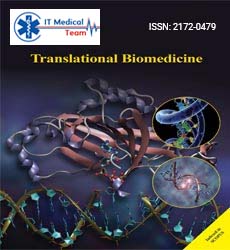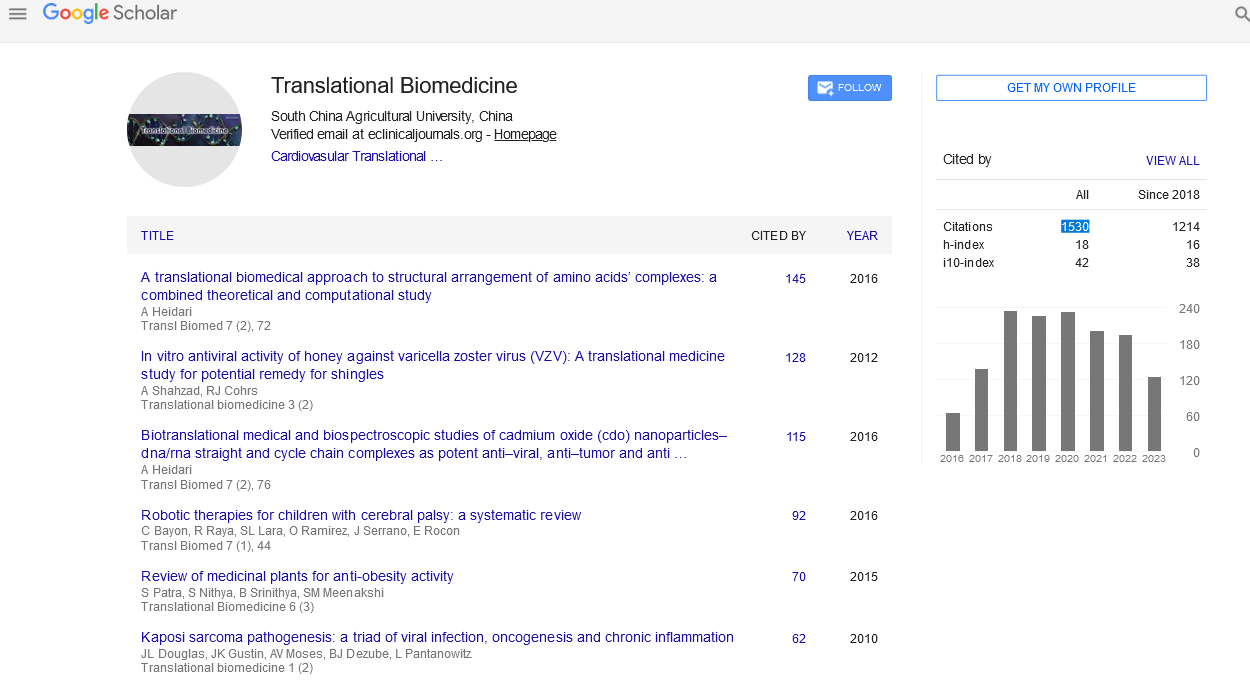Perspective - (2024) Volume 15, Issue 5
Systems Biology and its Role in Translational Biomedicine
Masaya Ito*
Department of Biomedicine, Toky University, Tokyo, Japan
*Correspondence:
Masaya Ito, Department of Biomedicine, Toky University, Tokyo,
Japan,
Email:
Received: 10-Sep-2024, Manuscript No. IPTB-24-15182;
Editor assigned: 13-Sep-2024, Pre QC No. IPTB-24-15182 (PQ);
Reviewed: 27-Sep-2024, QC No. IPTB-24-15182;
Revised: 01-Oct-2024, Manuscript No. IPTB-24-15182 (R);
Published:
29-Oct-2024
Introduction
Systems biology, a rapidly evolving field at the intersection of
biology, mathematics and computer science, offers profound
insights into the complexity of biological systems. Its integration
into translational biomedicine represents a promising frontier for
advancing medical science. This article explores the principles of
systems biology, its applications and how it is transforming
translational biomedicine by improving our understanding of
disease mechanisms and facilitating the development of novel
therapeutic strategies.
Description
Principles of systems biology
Systems biology is characterized by its holistic approach to
studying biological systems. Unlike traditional reductionist
methods that focus on individual components, systems biology
emphasizes the interactions between components within a
biological system. This approach seeks to understand how these
interactions give rise to the system's emergent properties. Key
concepts in systems biology include:
Network theory: Biological systems are often described in
terms of networks, such as gene regulatory networks, proteinprotein
interaction networks and metabolic pathways. Network
theory helps elucidate how components interact to regulate
biological functions and how disruptions in these interactions
can lead to disease.
Dynamic modeling: Biological systems are dynamic and
evolve over time. Systems biology employs mathematical
models to simulate these dynamics and predict how systems
respond to perturbations, such as genetic mutations or drug
treatments.
Integration of omics data: Systems biology integrates data
from various omics fields-genomics, proteomics, metabolomics
and transcriptomics-to provide a comprehensive view of
biological processes. This integration allows for a more holistic
understanding of how different molecular layers interact.
Applications in translational biomedicine
Translational biomedicine aims to bridge the gap between
basic research and clinical application. Systems biology
contributes to this goal in several impactful ways:
Disease mechanism elucidation: Systems biology approaches
can uncover the underlying mechanisms of complex diseases by
analyzing how disruptions in molecular networks lead to
pathological states. For instance, in cancer research, systems
biology has been used to map out the intricate networks of
signaling pathways involved in tumorigenesis, leading to better
understanding and targeted therapies.
Biomarker discovery: By integrating multi-omics data,
systems biology helps identify novel biomarkers that can be used
for disease diagnosis, prognosis and monitoring treatment
responses. These biomarkers can be critical for developing
personalized medicine approaches tailored to individual
patients' molecular profiles.
Drug discovery and development: Systems biology enhances
drug discovery by providing insights into the complex
interactions between drugs and biological systems. This
approach helps in identifying potential drug targets,
understanding drug mechanisms of action and predicting
adverse effects. For example, systems biology has been
instrumental in developing targeted therapies for diseases such
as breast cancer and rheumatoid arthritis.
Case studies and success stories
Several case studies highlight the success of systems biology
in translational biomedicine:
Cancer research: The Cancer Genome Atlas (TCGA) is a
prominent example of how systems biology has advanced cancer
research. TCGA integrates genomic, transcriptomic and
proteomic data to provide a comprehensive view of cancer
biology. This initiative has led to the identification of key cancerrelated
genes and pathways, facilitating the development of
targeted therapies.
Cardiovascular diseases: Systems biology approaches have
been applied to study cardiovascular diseases by mapping out
the complex interactions between genetic, environmental and
lifestyle factors. This research has led to the discovery of new biomarkers for heart disease and insights into the mechanisms
underlying conditions such as hypertension and atherosclerosis.
Neurodegenerative diseases: In neurodegenerative diseases
like Alzheimer's and Parkinson's, systems biology has been used
to unravel the complex molecular networks involved in disease
progression. This research has contributed to the identification
of potential therapeutic targets and the development of new
diagnostic tools.
Challenges and future directions
Despite its potential, systems biology faces several challenges:
Data integration: Integrating diverse types of omics data
remains a significant challenge. Developing effective methods
for combining these data types and extracting meaningful
insights is crucial for advancing systems biology research.
Model complexity: Building accurate and predictive models of
biological systems requires sophisticated computational tools
and a deep understanding of biological processes. Ensuring that models are both accurate and manageable is an ongoing
challenge.
Clinical translation: Translating systems biology findings into
clinical practice requires collaboration between researchers,
clinicians and industry stakeholders. Bridging this gap and
ensuring that discoveries lead to tangible benefits for patients is
a critical challenge.
Conclusion
Systems biology represents a powerful approach to
understanding the complexity of biological systems and
translating this knowledge into clinical practice. By integrating
multi-omics data, modeling dynamic interactions and elucidating
disease mechanisms, systems biology is advancing translational
biomedicine and paving the way for innovative therapies and
personalized medicine. As the field continues to evolve, it holds
the promise of delivering significant benefits to patients and
revolutionizing the future of medical science.
Citation: Ito M (2024) Systems Biology and its Role in Translational Biomedicine. Transl Biomed. Vol.15 No.5: 047





